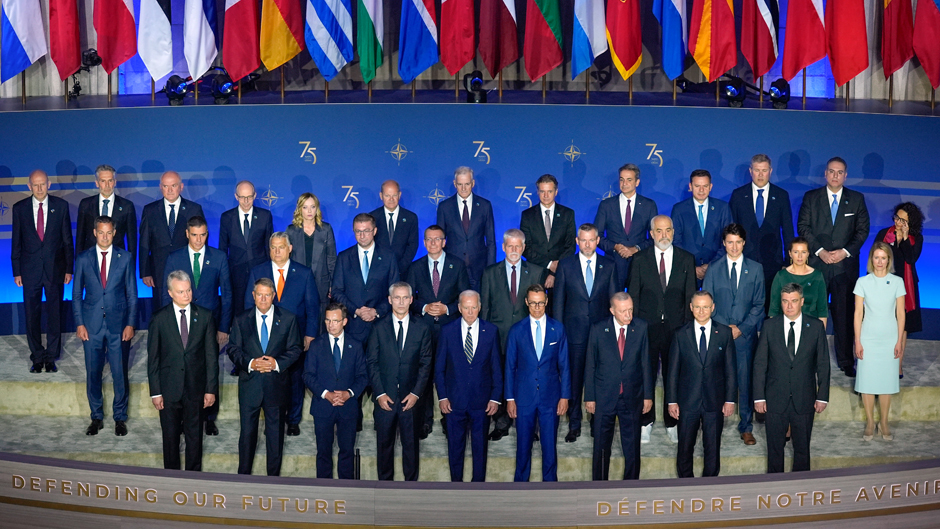The North Atlantic Treaty Alliance (NATO) celebrates its 75th anniversary this year as the longest standing military alliance in the history of the world. Yet, as the bloc’s 32 heads of state and heads of government convene this week for NATO’s annual summit, their mood might not be celebratory.
The alliance faces a cascade of complex challenges, most notably, how to end the war in Ukraine, at a time when the political permanence of several key heads of states—among them U.S. President Joe Biden and former Dutch Prime Minister Mark Rutte, the new secretary-general beginning Oct. 1—is in question.
Hermann Beck, a professor in the University of Miami College of Arts and Sciences Department of History, Cooper Fellow, and specialist in modern Germany and modern Europe, outlined key facets of NATO’s formation in 1949, some of its pivotal points and milestones, and its unique collective consensus decision-making model.
NATO’s beginning
“NATO was founded in response to a real and perceived threat from the Soviet Union,” Beck said. “With the downfall of Nazi Germany in May 1945, it became increasingly clear that the main raison d'être for the wartime alliance of the ‘Big Three’—the United States, Soviet Union, and United Kingdom—had disappeared.”
Following World War II and despite the deteriorating relations among the Big Three, the U.S. Army began to demobilize—reducing from 12 million soldiers to 3 million and by 1947 to 1.5 million soldiers, Beck noted.
“Yet while the armies of democracy melted away, there was no corresponding reduction in Soviet strength,” he said.
In 1946 and 1947, Eastern European countries, such as Poland, Rumania, Bulgaria, and Hungary, had gradually been taken over by Communists.
Increasing insurgency in the Balkans—in imminent danger of falling into the camp of communism—prompted then U.S. President Harry S. Truman to ask Congress for immediate financial and military aid. The “Truman Doctrine” is generally considered the official declaration of the Cold War and the beginning of the policy of containment of communism.
In February 1948, communists also took over Czechoslovakia and, in June 1948, the Soviet Union blockaded access routes to West Berlin, the three western zones of the German capital, which was entirely surrounded by the Soviet zone of occupation. It was during this tense crisis that NATO was founded in April 1949.
“It is difficult to speak of victories or defeats, but the time when NATO’s resolve was most hotly tested was at the height of the Cold War, in the late 1950s and early 1960s,” Beck said. “It is difficult to see how the Cold War could have been brought to a successful conclusion without NATO.”
While the immediate impetus for the formation of NATO was the Berlin blockade, in large part the bloc aimed to prevent a repeat of Hitler’s aggression that provoked World War II, Beck said.
He noted that NATO's first general secretary, Lord Hastings L. Ismay, put it cogently: “It was the goal of the alliance to keep the Americans in [Europe], the Russians out, and the Germans down.”
Germany’s complicated role
A specialist in Germany’s political, intellectual, and diplomatic history, Beck noted that despite this original intention, the continued presence of the Soviet threat prompted West Germany to seek entrance into the alliance, despite strong domestic opposition (in 1955).
From the 1960s to the 1980s, the German armed forces of about half a million men were among the most significant contributions among NATO member states, and in 1963 Germany’s military budget rose to 4.9 percent of GDP. Yet with the end of the Cold War and elimination of the Soviet threat, beginning in 1992 its military budget fell below 2 percent and dipped to its nadir in 2005 at barely over 1 percent, according to Beck.
Under the impact of the war in Ukraine, Germany’s military budget is again rising above 2 percent, he noted.
A unique decision-making model
NATO member countries decide on global political and security issues by collective consensus. Beck noted the challenges to this approach.
“There has not always been consensus among NATO member states. In 1974, two of them, Greece and Turkey, even went to war against each other over Cyprus, and in 1966 France withdrew from the integrated military structure of the alliance (and later rejoined in 1995)."
In response to Russia's invasion of Ukraine and the potential of continued Russian aggression toward NATO members states (such as the Baltic states or Poland), unity and cohesion among the European members of NATO have again increased, he pointed out.
Critical role of the United States
“Led by the United States, which has been consistently the greatest contributor to its budget, NATO has proved supple and malleable in how it dealt with the Soviet opponent: from George Kennan's ‘policy of containment,’ to John Foster Dulles's ‘massive retaliation,’ to the flexible response of the 1960s through 1980s,” Beck said. “Under the undisputed leadership of the United States, NATO always came up with a timely response to the challenges posed.”
The greatest challenges may be yet to come in case a future American president were to decide to decrease or completely withdraw support, the historian posited.
“Without America to set the course and, if necessary, compel occasionally uncertain European brethren to follow a straight and narrow road, it is doubtful if cantankerous Europeans can keep the ship on course,” Beck said.
In a recent webinar, Julianne Smith, the U.S. permanent representative to NATO, acknowledged the challenges that Ukraine faces in the ongoing war, especially in terms of weapons supply. Smith said that NATO will announce at the summit its plans for a new headquarters to better coordinate assistance to support Ukraine’s “remarkable fighting spirit.”

